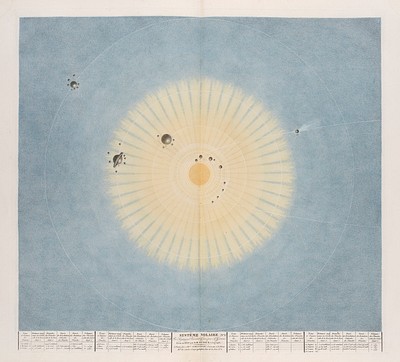van Roomen, Canon Triangulorum
Lot 221
Absentee vs Live bid
Two ways to bid:
- Leave a max absentee bid and the platform will bid on your behalf up to your maximum bid during the live auction.
- Bid live during the auction and your bids will be submitted real-time to the auctioneer.
Bid Increments
| Price | Bid Increment |
|---|---|
| EUR€0 | EUR€10 |
| EUR€100 | EUR€10 |
| EUR€200 | EUR€20 |
| EUR€300 | EUR€30 |
| EUR€420 | EUR€30 |
| EUR€480 | EUR€20 |
| EUR€500 | EUR€50 |
| EUR€2,000 | EUR€200 |
| EUR€3,200 | EUR€300 |
About Auction
By Jeschke Jádi Auctions Berlin GmbH
Dec 15, 2022
Set Reminder
2022-12-15 09:00:00
2022-12-15 09:00:00
America/New_York
Bidsquare
Bidsquare : Auction 145 – Rare Books, Decorative Prints, Historical Photography
https://www.bidsquare.com/auctions/jeschke-van-vliet/auction-145-rare-books-decorative-prints-historical-photography-11466
Jeschke Jádi Auctions Berlin GmbH info@jvv-berlin.de
Jeschke Jádi Auctions Berlin GmbH info@jvv-berlin.de
- Lot Description
Mathematik Roomen (Romanus), Adriaan van Adriani Romani Canon Triangulorum Sphaericorum, Brevissimus simul ac facilimus quamplurimisq(ue) exemplis opticae proiectis illustratus, in gratiam Astronomiae, Cosmographiae, Geographiae, Horologio-graphiae, &c. studiosorum iam primum editus accessere plenioris usus ergo. Tabulae Sinuum, Tangentium, et Secantium, ex opere. Mit Holzschnitt-TVignette u. zahlr. tls. in Rot u. Schwarz gedruckten Kreis-Figuren. Mainz, Albinus, 1609. Quarto (225 x 165 mm) 6 unpag. Bl., S. 9-315. Gr.-8°. Spät. HPgt. auf 5 durchgezogenen Bünden mit rot gesprenkeltem Schnitt, marmor. Buntpapierbezug u. goldgepr. RSchild. First edition of this very rare work on spherical trigonometry, which contains the first systematic use of a trigonometric notation, and in which the author speaks of François Viète's recent use of analysis. This copy lacks the 91 pages of Clavius' reprint of the tables, which was published as early as 1607 and partially bound in as the second part. - Van Roomen is best known for posing a problem in 1593, which involved the solution of an equation of degree 45. The solution of this problem in 1595 made François Viète one of the most important mathematicians of his time, as he demonstrated the importance of trigonometry for the solution of algebraic equations. A friendship subsequently developed between Viète and van Roomen. Viète suggested to Roomen as an approach to draw a circle touching 3 given circles (the Apollonian problem), and van Roomen solved the problem using hyperbolas and published the result in 1596. In the preface ("De operis praesentis ordine"), the author speaks of Viète's new use of calculus ("Hisce incommondis ante paucos annos Franciscus Vieta ... medelam attulit, novis propositis praxibus ..."). "In his terminology, van Roomen imitated Viète by using the expressions 'prosinus' and 'transinuosa' for tangent and secant respectively." (Busard). - During the sixteenth century, several mathematicians eagerly set about calculating trigonometric tables. Some, such as Georg Joachim Rheticus, were eventually successful, others, such as Adrianus Romanus (1561-1615) and Christoph Grienberger, left their work unfinished. At the beginning of 1593 Romanus' Ideae Mathematicae pars prima, sive methodus polygonorum was published (which contained four of the twelve planned chapters) and is to be regarded as the fundamental starting point for the calculation of chords and sines for all of mathematics and especially for astronomy. - Somewhat browned due to paper, some brownspots and waterstains. Erste Ausgabe dieser sehr seltenen Arbeit über sphärische Trigonometrie, die die erste systematische Verwendung eines trigonometrischen Notation enthält, und in der der Autor von François Viètes jüngster Nutzung der Analysis spricht. In diesem Exemplar fehlen die 91 Seiten des Nachdrucks der Tabellen von Clavius, der bereits 1607 veröffentlicht und teilweise als zweiter Teil mitgebunden wurde. - ABPC listet nur ein Exemplar auf, das in den letzten 30 Jahren versteigert wurde. - VD17 39:121632N. - DSB XI, 532-34. - Nicht in Tomash, nicht in BEA. - Lit.: Paul Bockstaele. Adrianus Romanus und die trigonometrischen Tabellen von Georg Joachim Rheticus, in: Amphora. Festschrift für Hans Wussing, S. 55ff. - KVK: Amberg, Stabi München (mit Clavius), UB Gießen (ohne Clavius), 5 Kopien in Italien (teilw. ohne Clavius), Solothurn (nur Clavius), BL London (2 Tle.), Kopenhagen (1 Tl. u. 2 Tle.) u.a. - Van Roomen ist vor allem dafür bekannt, dass er 1593 ein Problem aufwarf, bei dem es um die Lösung einer Gleichung vom Grad 45 ging. Die Lösung dieses Problems im Jahr 1595 machte François Viète zu einem der wichtigsten Mathematiker seiner Zeit, da er die Bedeutung der Trigonometrie für die Lösung algebraischer Gleichungen aufzeigte. In der Folge entwickelte sich eine Freundschaft zwischen Viète und van Roomen. Viète schlug Roomen als Ansatz vor, einen Kreis zu zeichnen, der 3 gegebene Kreise berührt (das Apollonische Problem), und van Roomen löste das Problem mit Hilfe von Hyperbeln und veröffentlichte das Ergebnis 1596. In der Vorrede ("De operis praesentis ordine") spricht der Autor von Viètes neuer Verwendung der Analysis ("Hisce incommondis ante paucos annos Franciscus Vieta ... medelam attulit, novis propositis praxibus ..."). "In seiner Terminologie ahmte van Roomen Viète nach, indem er die Ausdrücke 'prosinus' und 'transinuosa' für Tangente bzw. Sekante verwendete." (Busard). - Im Laufe des sechzehnten Jahrhunderts machten sich mehrere Mathematiker eifrig an die Berechnung trigonometrischer Tabellen. Einige, wie Georg Joachim Rheticus, waren schließlich erfolgreich, andere, wie Adrianus Romanus (1561-1615) und Christoph Grienberger, ließen ihre Arbeit unvollendet. Anfang 1593 wurde Romanus' Ideae Mathematicae pars prima, sive methodus polygonorum veröffentlicht (die vier der insg. zwölf geplanten Kapitel enthielt) und als grundlegender Ausgangspunkt für die Berechnung von Sehnen und Sinus für die gesamte Mathematik und vor allem für die Astronomie zu betrachten ist. - Papierbedingt tls. stärker gebräunt, tls. braunfleckig u. wasserrandig. * Dieses Werk ist regelbesteuert. Auf den Zuschlagspreis fallen 23,95% Aufgeld sowie auf den Rechnungsendbetrag 7% bzw. 19% Mehrwertsteuer in der Europäischen Union an. This work is subject to the regular margin scheme. There is a 23.95% buyer's premium on the hammer price and 7% or 19% VAT on the final invoice amount in the European Union.Roomen (Romanus), Adriaan van Adriani Romani Canon Triangulorum Sphaericorum, Brevissimus simul ac facilimus quamplurimisq(ue) exemplis opticae proiectis illustratus, in gratiam Astronomiae, Cosmographiae, Geographiae, Horologio-graphiae, &c. studiosorum iam primum editus accessere plenioris usus ergo. Tabulae Sinuum, Tangentium, et Secantium, ex opere. Mit Holzschnitt-TVignette u. zahlr. tls. in Rot u. Schwarz gedruckten Kreis-Figuren. Mainz, Albinus, 1609. Quarto (225 x 165 mm) 6 unpag. Bl., S. 9-315. Gr.-8°. Spät. HPgt. auf 5 durchgezogenen Bünden mit rot gesprenkeltem Schnitt, marmor. Buntpapierbezug u. goldgepr. RSchild.
Condition
- Buyer's Premium



 EUR
EUR CAD
CAD AUD
AUD GBP
GBP MXN
MXN HKD
HKD CNY
CNY MYR
MYR SEK
SEK SGD
SGD CHF
CHF THB
THB





